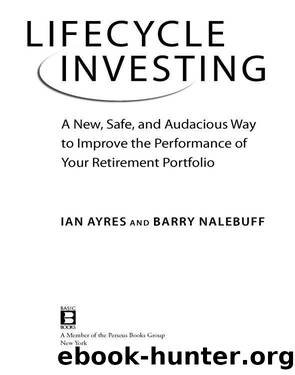Lifecycle Investing by Ian Ayres

Author:Ian Ayres
Language: eng
Format: epub
Publisher: Basic Books
Published: 2010-04-11T16:00:00+00:00
Saving for College (and a Rainy Day)
Most of us have lots of different cookie jars for savings. One jar is for retirement, another for the kidsâ college, another for an emergency. Even if the jars arenât real, we keep mental accounts of how our savings is to be allocated across different pots. This begs the question of whether itâs okay to commingle the different funds and, if so, how you should do it.
To answer that question, letâs say that you are forty with $90,000 already saved for retirement and $50,000 saved for your kidsâ college tuition, and the value of your future savings contributions adds another $310,000. Thus your total savings are $450,000. How much of that $450,000 should you invest in equities?
The first part of the answer depends on your strategy. Say, you choose to follow a 200/50 path, so youâd like to put half of your total retirement savings into equities. But your total retirement savings isnât $450,000 because $50,000 of that amount is earmarked for tuition. Therefore, you should apply the 50 percent Samuelson share to $400,000, for a goal of $200,000. Of course, you donât have $200,000 available today, so youâll need to use some leverage.
Now the question is whether you should leverage the $90,000 earmarked for retirement at 200 percent leverage or take the full $140,000 and leverage that amount at just 143 percent to hit your $200,000 goal. Here, commingling is a good idea. It lets you get to your $200,000 goal that you otherwise wouldnât quite make investing only the $90,000. What that means in practice is that you might borrow $60,000 on margin or invest $60,000 at 2:1 leverage and invest the other $80,000 without leverage.6
What youâve really done is âborrowâ the $50,000 earmarked for college and put it to use temporarily in equities. The fact that you have this cash available today allows you to take a bit more market exposure: You can get all the way to $200,000 rather than limiting yourself to $180,000. And using the $50,000 in savings reduces your need for outside borrowing. You are borrowing from yourself before going elsewhere.
But what if a $20,000 tuition bill arrives, and you have all your liquid assets invested in stocks? At this point you have to come up with the money. One option is to take out a loan. The Federal PLUS loan program (for parents with good credit) offers loans at 8.5 percent, minus 0.25 percent if you enroll in automatic debit.7 While that is better than most credit cards, it is still too high to justify borrowing in order to buy stocks with leverage. Not taking the loan is like getting an 8.25 percent risk-free, tax-free return on your money. Thatâs a better deal than investing in stocks. So donât take out the loan if you have any other assets available.
In our example, you had $140,000 available that was invested at 143 percent leverage. The solution to your liquidity needs is to take $20,000 out of the equity, leaving $120,000.
Download
This site does not store any files on its server. We only index and link to content provided by other sites. Please contact the content providers to delete copyright contents if any and email us, we'll remove relevant links or contents immediately.
Harry Potter and the Goblet Of Fire by J.K. Rowling(3045)
Never by Ken Follett(2880)
Shadow of Night by Deborah Harkness(2718)
Ogilvy on Advertising by David Ogilvy(2682)
Zero to IPO: Over $1 Trillion of Actionable Advice from the World's Most Successful Entrepreneurs by Frederic Kerrest(2394)
The Man Who Died Twice by Richard Osman(2299)
Machine Learning at Scale with H2O by Gregory Keys | David Whiting(2291)
Book of Life by Deborah Harkness(2263)
How Proust Can Change Your Life by Alain De Botton(2261)
My Brilliant Friend by Elena Ferrante(2223)
0041152001443424520 .pdf by Unknown(2220)
The Tipping Point by Malcolm Gladwell(2204)
How to Pay Zero Taxes, 2018 by Jeff A. Schnepper(2099)
Will by Will Smith(2041)
Purple Hibiscus by Chimamanda Ngozi Adichie(1981)
Hooked: A Dark, Contemporary Romance (Never After Series) by Emily McIntire(1959)
Borders by unknow(1785)
Rationality by Steven Pinker(1765)
Daughter of Smoke and Bone by Laini Taylor(1744)
